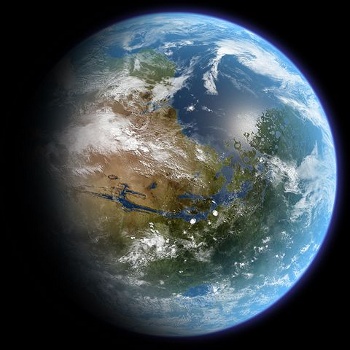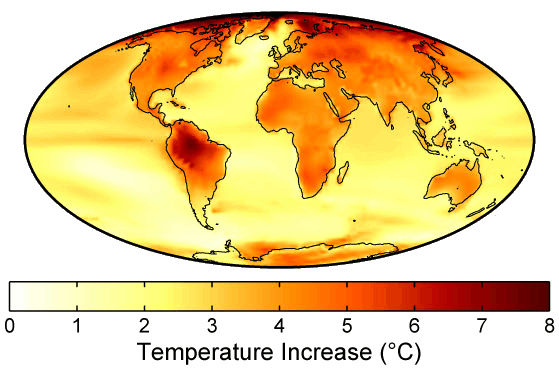Geoengineering
October 24, 2012
Humans have been purposefully sculpting the
Earth ever since we arrived on the scene. It started simply, as we made our
cave dwellings just a little larger and less cluttered. Then, by the
last century, we
dammed and diverted
rivers, paved a lot of surface area with heat-absorbing
asphalt, and pumped
gases that cause
global warming into the
atmosphere. Hey, that's how we are - We're always trying to improve our environment.
I reviewed possible mechanisms for changing
planetary environments on a grand scale in a
previous article (Terraforming, May 11, 2012).
Terraforming, the
hypothetical process of modifying a
planet to make it more Earth-like, consists of modifying a planet's
atmosphere and
temperature to allow
Earth-like vegetation to take root and reform its environment.
Mars has always appeared to be the
easiest challenge among the planets of our own
Solar System,[1-3] but this is a process that would take tens of thousands, or hundreds of thousands, of years. We can't expect any sort of
geoengineering we do here on Earth to have a near-term impact that mitigates some of out global environmental problems, can we?

A pale blue dot, with a little red.
Artist's impression of a terraformed Mars, centered over Valles Marineris.
(Illustration by Daein Ballard, via Wikimedia Commons)
Research published earlier this year showed that changing the average
temperature of a portion of the Earth over a span of
decades is actually not that difficult.[4-6] In a large-scale environmental
experiment facilitated by the
US Clean Air Act, it was found that atmospheric
particulates had offset global warming for a few decades over a sizable portion of the Earth.
Atmospheric particulates cause cooling by
reflecting sunlight back into
space. In the US,
sulfates from
coal-fired power plants were responsible for much of this
particulate pollution. Since these were found to cause
acid rain, their reduction was mandated by
legislation.
The
Eastern United States, which had suffered under acid rain during the late
twentieth century, was found to have been a bit cooler because of the heat-shielding affect of these particulates. This heat-shielding was localized to this region, since these particulates were generated locally and remained in the atmosphere for only about a week. Although
global mean temperature rose about 0.8 °C from 1906 to 2005, temperatures in the Eastern United States decreased 1 °C from 1930-1990.[5-6]
Such a finding has encouraged
scientists to look at the possibility of using this and similar processes as a way of geoengineering against global warming. Since we're always worried about
unintended consequences, it's encouraging that this idea has already been proven by a long-term, albeit accidental, experiment, and the affects of pumping particulates into the atmosphere are short-term.

Worst Case Scenario. If the world proceeds in a "business-as-usual" fashion in which nothing is done to address global warming, this is what we should expect at the end of this century. The data are from the Hadley Centre HadCM3 climate model. (Via Wikimedia Commons))
Douglas G. MacMartin of the
California Institute of Technology,
David W. Keith of
Harvard's School of Engineering and Applied Sciences, along with
Ben Kravitz and
Ken Caldeira of the
Carnegie Institution have just published a paper in
Nature Climate Change that addresses some of the problems associated with geoengineering.[7-9] One of these is the desirability of a uniform reduction in
insolation, such that the climate change in all regions of the Earth would be the same; or, as described in their paper, there's a need to reduce the
root-mean-square residual climate change.
This study specifically addressed the possibility of using geoengineering to save remaining
Arctic sea ice, or even to reverse this ice melt.[7-8] The geoengineering toolkit includes more than just increasing the concentrations of aerosols in the stratosphere. Another major method of solar radiation management is the creation of
low-altitude marine clouds.[7-8]
The major problem with implementation of such measures is that their influence will vary by region.[8] Climate systems respond differently to solar reflectors than to atmospheric
carbon dioxide, which has a uniform, global warming affect.[8] A uniform layer of stratospheric aerosols would cool the
tropics much more than the
north or
south polar areas.[8]
To effectively implement geoengineered cooling measures, it would be necessary to vary the amount of sunlight deflection both regionally and
seasonally.[7] The research team
modeled ways to maximize the benefits of these cooling measures while minimizing their side-effects, such as
ozone depletion if sulphates are used.[8-9]
Variation of geoengineering by region and over different periods could improve its effectiveness and reduce unfavorable climate impact in at-risk areas.[7] Says Harvard co-author of the study, David Keith, "We found that tailored solar geoengineering might limit Arctic sea ice loss with several times less total solar shading than would be needed in a uniform case."[7]
Other papers on geoengineering have started to appear,[10] but it's best to follow the proverb that
an ounce of prevention is worth a pound of cure. Says Carnegie Institution coauthor, Ken Caldeira, "The safest way to reduce climate risk is to reduce greenhouse gas emissions."[8]
References:
- Terraforming Mars, NASA Web Site.
- Martyn J. Fogg, Tom Meyer, Stephen Gillett and Robert Haynes, "Planetary Engineering Bibliography," NASA, November 1995.
- M.J. Fogg, Terraforming Information Pages.
- Caroline Perry, "'Warming hole' delayed climate change over eastern United States," Harvard School of Engineering and Applied Sciences Press Release, April 26, 2012.
- E. M. Leibensperger, L. J Mickley, D. J. Jacob, W.-T. Chen, J. H. Seinfeld, A. Nenes, P. J. Adams, D. G. Streets, N. Kumar and D. Rind,"Climatic effects of 1950–2050 changes in US anthropogenic aerosols – Part 1: Aerosol trends and radiative forcing," Atmos. Chem. Phys., vol. 12 (2012), pp. 3333-3348.
- E. M. Leibensperger, L. J Mickley, D. J. Jacob, W.-T. Chen, J. H. Seinfeld, A. Nenes, P. J. Adams, D. G. Streets, N. Kumar and D. Rind,"Climatic effects of 1950–2050 changes in US anthropogenic aerosols – Part 2: Climate response," Atmos. Chem. Phys., vol. 12 (2012), pp. 3349-3362.
- Targeting solar geoengineering to minimize risk and inequality, Harvard School of Engineering and Applied Sciences Press Release, October 21, 2012.
- Improving effectiveness of solar geoengineering, Carnegie Institution Press Release, October 22, 2012.
- Douglas G. MacMartin, David W. Keith, Ben Kravitz and Ken Caldeira, "Management of trade-offs in geoengineering through optimal choice of non-uniformradiative forcing," Nature Climate Change (Published online,October 21, 2012), doi:10.1038/nclimate1722.
- F. D. Pope, P. Braesicke, R. G. Grainger, M. Kalberer, I. M. Watson, P. J. Davidson and R. A. Cox, "Stratospheric aerosol particles and solar-radiation management," Nature Climate Change, vol. 2, no. 10 (October 2012), pp. 713-719.
Permanent Link to this article
Linked Keywords: Humans; Earth; cave dweller; cave dwelling; 20th century; dam; river; asphalt; gas; global warming; atmosphere of Earth; planet; terraforming; hypothesis; hypothetical; atmosphere; temperature; Earth-like vegetation; Mars; terraforming of Mars; Solar System; geoengineering; pale blue dot; Wikimedia Commons; temperature; decade; experiment; US Clean Air Act; particulate; reflection; sunlight; space; sulfate; coal-fired power plant; particulate pollution; acid rain; legislation; Eastern United States; twentieth century; global mean temperature; scientist; unintended consequences; Hadley Centre for Climate Prediction and Research; HadCM3 climate model; Douglas G. MacMartin; California Institute of Technology; David W. Keith; Harvard University; School of Engineering and Applied Sciences; Ben Kravitz; Ken Caldeira; Carnegie Institution for Science; Nature Climate Change; insolation; root-mean-square; Arctic sea ice; low-altitude; marine cloud; carbon dioxide; tropics; Arctic; Antarctic; season; computer simulation; computer model; ozone depletion; proverb; an ounce of prevention is worth a pound of cure.